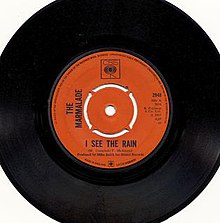I See the Rain
| "I See the Rain" | ||||
|---|---|---|---|---|
 | ||||
| Single by The Marmalade | ||||
| from the album There’s A Lot Of It About | ||||
| B-side | "Laughing Man" | |||
| Released | 25 August 1967 | |||
| Recorded | CBS Studio New Bond St London | |||
| Genre | Rock | |||
| Length | 4:05 | |||
| Label | CBS Records | |||
| Songwriter(s) | Junior Campbell, Dean Ford | |||
| Producer(s) | Mike Smith - Engineer | |||
| The Marmalade singles chronology | ||||
| ||||
"I See the Rain" is a 1967 song recorded by The Marmalade, written by lead guitarist William Junior Campbell and vocalist Dean Ford (born Thomas McAleese).[1]
This was the band's third CBS Records release, following their 1966 name change from Dean Ford and the Gaylords and change of label from Columbia (EMI) to CBS, and was one year before their first successful UK release "Lovin' Things". The self-penned recording was praised by Jimi Hendrix as the "best cut of 1967."[2]
The recording became a chart-topper in the Netherlands that same year. Graham Nash of The Hollies, contributed to the session, but it did not chart in the UK, although the track, with its distinct mid-1960s psychedelic feel, has since attained a cult following and has been covered by artists such as Susanna Hoffs of The Bangles and Matthew Sweet (see Under the Covers, Vol. 1).[3]
The Marmalade's original recording also was used in an advertisement campaign by Gap Inc. in 2002.[4] A commercial was directed by the Coen brothers and featured Dennis Hopper and Christina Ricci.[5]
References[]
- ^ "I See the Rain - Marmalade - Song Info". AllMusic. Retrieved 2 January 2019.
- ^ "Marmalade - Biography & History". AllMusic. Retrieved 2 January 2019.
- ^ "Under the Covers, Vol. 1 - Susanna Hoffs, Matthew Sweet - Songs, Reviews, Credits". AllMusic. Retrieved 2 January 2019.
- ^ "Gap - Two White Shirts - The Marmalade - I See the Rain (2002) - 0:30 (USA)". Adland.tv. 12 June 2002. Retrieved 2 January 2019.
- ^ "Top directors plug the Gap". News.bbc.co.uk. 26 April 2002. Retrieved 2 January 2019.
- 1967 singles
- CBS Records singles
- Marmalade (band) songs
- 1967 songs
- Songs written by Junior Campbell